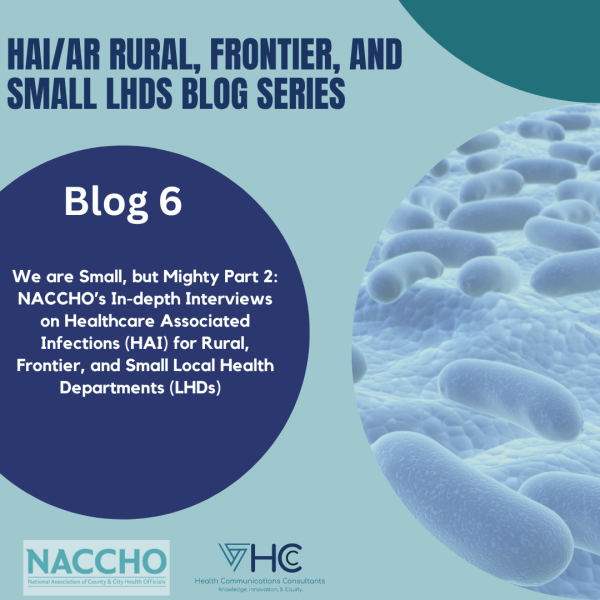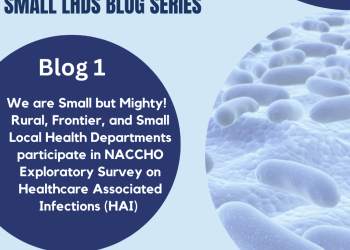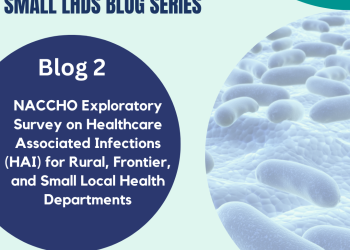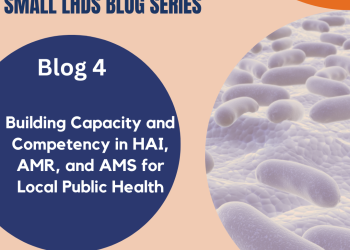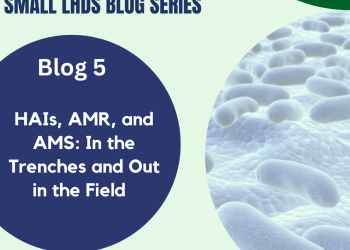NACCHO’s In-depth Interview
In May 2022, NACCHO conducted in-depth interviews of 11 Rural, Frontier, and Small LHDs who were engaged or not engaged in activities for Healthcare Associated Infections (HAI), Antimicrobial Resistance (AMR), and/or Antimicrobial Stewardship (AMS). The in-depth interviews had the following goals:
- Assess performance for Rural, Frontier, and Small LHDs and their partnerships collaborations engaged in HAI, AMR, and AMS initiatives.
- Assess barriers for Rural, Frontier, and Small LHDs not currently engaged in HAI, AMR, and AMS initiatives.
- Inform on workforce development and capacity building for LHDs engaged or not engaged in HAI, AMR, and AMS initiatives.
In-depth Interview LHDs
NACCHO extends a warm thank you to the 11 organizations who participated in the in-depth interviews on HAI, AMR, and/or AMS activities or initiatives.
LHDs Engaged in HAI Initiatives
| LHDs Not Engaged in HAI Initiatives
|
Key Findings
Assessing Performance
Program successes for those engaged in HAI, AMR, and/or AMS activities were based on quality partnerships with consistent communications, up to date guidance, continual learning, desire to learn, supportive teams, and access to mentors and subject matter experts. Timely reporting of cases and outbreaks was a measure of success along with the level of engagement of partners in community activities, partnering for community outreach activities, and responding to surveys.
Assessing Barriers
Time, staffing, turnover, and funding were consistent barriers for both engaged and not engaged LHDs. Program barriers for those engaged were heavily based on funding, turnover at the LHD and the healthcare facilities, time and resources to build competency and respond to an HAI issue, external perceptions of the health department by healthcare facilities, inefficient data systems, non-supportive legislations/policies which limited standardization, and competing responsibilities within and outside the program.
The key challenges for the not engaged LHDs were the lack of communication, information, and data from a State HAI Program. Another barrier was federal funding algorithms based on case incidence which put Rural, Frontier, and Small LHDs at a disadvantage. Not engaged LHDs reported that personnel and the community must be motivated to initiate any program.
Workforce Development & Capacity Building
Workforce development and capacity building opportunities were frequently overlooked if Rural, Frontier, and Small LHDs were not provided a direct invitation to participate in regional, state, and/or federal training or initiatives. These organizations want to be asked to the table to participate with clear standards and agreements in place due to their limited time, staff, and resources. The not engaged LHDs thought the best way to initiate engagement and make the greatest impact in HAI, AMR and AMS activities without additional funding was in messaging and education but that it had to be a direct ask with support in the form of an accessible point-of-contact and tailored resources.
Engaged organizations reported that staff must demonstrate a desire to learn and be open to being involved. Skillsets need to include people and communication skills, technical skills, academic experiences, and a basic knowledge of epidemiology and infection control. Training, in general, was perceived to be more effective in-person than in a virtual environment. The need for more hands-on training was identified by both engaged and not engaged LHDs along with experiential learning and continual education.
Recommendations
The in-depth interviews provided a wealth of data and yielded the following recommendations for Rural, Frontier, and Small LHDs considering engagement in HAI, AMR, and AMS initiatives:
1. Building an HAI, AMR, AMS Program/Project
HAI, AMR, and AMS program/project should fit into the work the LHD is already doing and incorporate both the LHD and community partners equally.
2. Understand the Needs of Rural, Frontier, and Small LHDs
Rural, Frontier, and Small LHDs have unique needs, cultures, and structures. Thus, building capacity requires collaboration in the form of facilitation and training as well as setting expectations, roles, and desired outcomes across agencies and partners.
3. Funding and Resources
Improved federal funding algorithms and application protocols should account for the need to fund infrastructure, capacity, and KSAs. Additionally, tools and resources should be specifically tailored to Rural, Frontier, and Small LHDs’ needs, cultures, and structures.
4. Training and Technical Assistance
Direct engagement of Rural, Frontier, and Small LHDs must involve personalization, peer-to-peer coaching and mentoring programs, and specific training for HAI, AMR, and AMS topics.
5. Tailored State Engagement
State HAI programs should personally reach out to Rural, Frontier, and Small LHDs and ask how they can engage in these activities specifically and ensure a point-of-contact for information, resources, public health orientation, and HAI, AMR, and AMS training.
What can Rural, Frontier, and Small LHDs do about HAIs, AMR, and AMS?
HAIs and AMR are a threat to a patient, and subsequently, public health safety. These kinds of infections are a significant cause of illness and death; they can have serious emotional, financial, and medical consequences. Rural, Frontier, and Small LHDs can provide leadership in surveillance, outbreak investigations, and prevention by collaborating with healthcare and community partners. The development and implementation of an AMS plan can improve antibiotic prescribing and use to effectively treat infections, protect patients from unnecessary antibiotic use, and combat antibiotic resistance.
Resources
- State-based HAI Prevention Activities – https://www.cdc.gov/hai/state-based/index.html
- National Action Plan to Prevent Health Care-Associated Infections – https://health.gov/about-odphp/previous-initiatives
- Healthcare Associated Infection Toolkits – https://www.cdc.gov/hai/prevent/prevention_tools.html
- Actions to Fight Antimicrobial Resistance – https://www.cdc.gov/drugresist...;
- AMR Communication Resources – https://www.cdc.gov/drugresistance/resources.html
- AMS Resources – https://apic.org/professional-practice/practice-resources/antimicrobial-stewardship/
- Core Elements of Hospital Antibiotic Stewardship Programs Tools & Resources – https://www.cdc.gov/antibiotic-use/core-elements/hospital.html
The copy of the complete report can be found here Rural Partnership in HAI, AMR, AMS (naccho.org) In-Depth Interviews Report.
This infographic also illustrates the major findings of the in-depth interviews.
